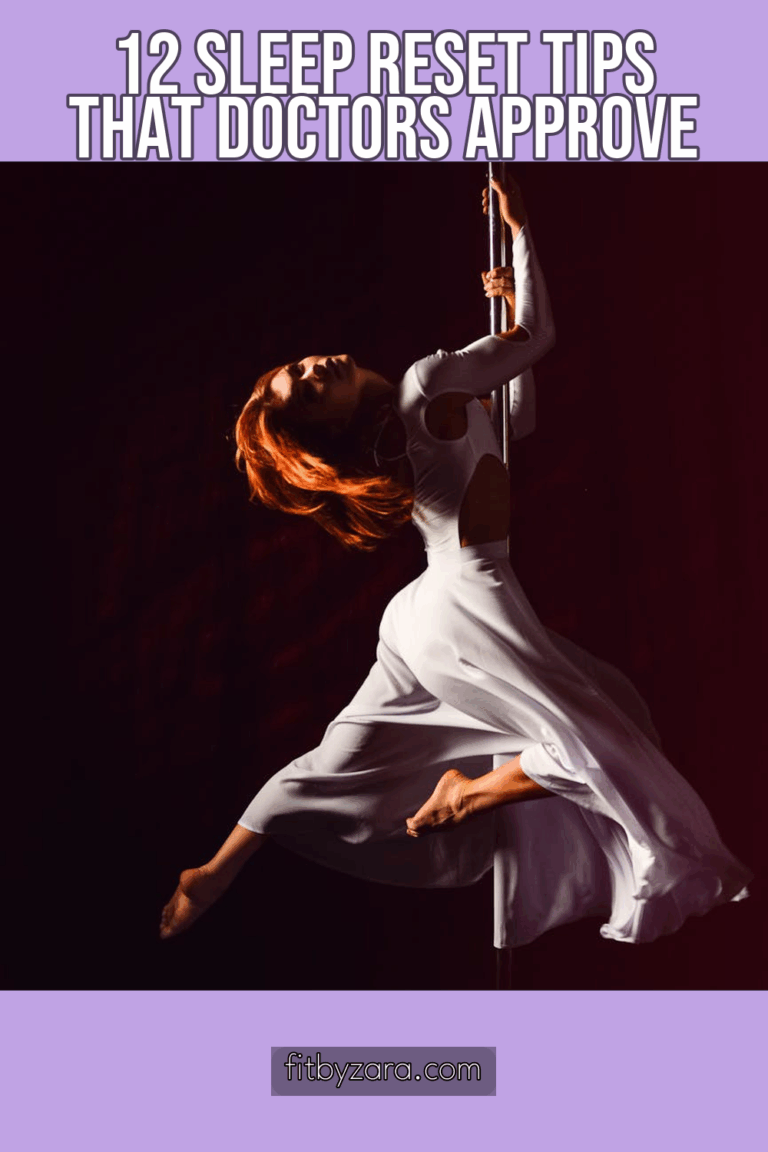As women in our 30s and beyond, we often juggle careers, family, and a million other responsibilities—leaving little room for the essential rest our bodies crave. If you’ve been tossing and turning at night or waking up feeling less than refreshed, it’s time for a sleep reset! Below, I’ve compiled 12 practical tips, all approved by health and wellness professionals, that can help you reclaim your sleep. Think of this as your mini workout for better rest!

Hi, I’m Zara — fitness junkie, wellness nerd, and the voice behind FitByZara.com. This site is all about smart fitness and science-backed wellness tips for real women who want to feel their best.
Why Sleep Matters
3-Day Energy & Metabolism Reset
Grab the 3-Day Energy & Metabolism Reset — a quick-start guide to feel lighter, more energized, and back in control.

Where should I send your free reset guide?
Before diving into our reset tips, let’s take a quick look at why sleep is essential. Quality sleep can enhance your mood, improve cognitive function, and even support your physical health. It’s your body’s way of rejuvenating and recharging, so let’s make it a priority!
1. Set a Consistent Sleep Schedule
Why It Works
Your body thrives on routine. Going to bed and waking up at the same time every day helps regulate your circadian rhythm.
Action Steps
- Choose a bedtime and wake-up time that you can stick to—even on weekends.
- Set an alarm for bedtime to remind you to wind down.
Mini Checklist
- [ ] Consistent bedtime
- [ ] Consistent wake-up time
- [ ] Weekend schedules aligned
—
2. Create a Relaxing Bedtime Routine
Why It Works
A calming routine signals your body that it’s time to wind down. Think of it as your psychological cue to transition from the hustle and bustle of the day to a state of relaxation.
Action Steps
- Dedicate 30 minutes before bed to activities like reading, meditating, or taking a warm bath.
- Limit screen time—consider using blue light-blocking glasses if you need to use devices.
Mini Checklist
- [ ] 30-minute wind-down period
- [ ] Relaxing activities planned
- [ ] Screens away
—
3. Optimize Your Sleep Environment
Why It Works
A sleep-friendly environment can dramatically improve sleep quality. Think of your bedroom as your sanctuary.
Action Steps
- Make your room dark, cool, and quiet. Consider blackout curtains, earplugs, or a white noise machine.
- Invest in a comfortable mattress and pillows that support your sleeping style.
Mini Checklist
- [ ] Dark curtains or blinds
- [ ] Comfortable bedding
- [ ] Quiet environment
—
4. Watch What You Eat and Drink
Why It Works
Certain foods and drinks can interfere with your sleep. Being mindful of your diet can lead to better rest!
Action Steps
- Avoid heavy meals and alcohol close to bedtime.
- Consider a light snack that includes sleep-friendly nutrients, like almonds or bananas.
Mini Checklist
- [ ] No heavy meals 2-3 hours before bed
- [ ] Snack options ready
- [ ] Limit caffeine intake after noon
—
5. Get Moving During the Day
Why It Works
Regular physical activity can help you fall asleep faster and enjoy deeper sleep. It’s a win-win for your body!
Action Steps
- Aim for at least 30 minutes of moderate exercise most days. This could be a brisk walk, yoga, or a dance class.
- Try to schedule your workouts earlier in the day—exercise too close to bedtime can energize you.
Mini Checklist
- [ ] Daily workout planned
- [ ] Morning or afternoon sessions preferred
- [ ] Variety in activities to keep it fun
—
6. Manage Stress and Anxiety
Why It Works
Stress can be a sleep thief. Managing your stress levels can lead to a more peaceful night’s sleep.
Action Steps
- Incorporate mindfulness practices, such as meditation or deep-breathing exercises, into your day.
- Journaling can also help clear your mind of racing thoughts before sleep.
Mini Checklist
- [ ] Daily mindfulness practice
- [ ] Journaling materials on hand
- [ ] Stress-management techniques explored
—
7. Limit Naps
Why It Works
While short naps can be refreshing, long or late-afternoon naps can disrupt your nighttime sleep cycle.
Action Steps
- Keep naps to 20-30 minutes, ideally before 3 PM.
- If you feel the need to nap, schedule it as part of your day.
Mini Checklist
- [ ] Nap times planned
- [ ] Duration limited to 30 minutes
- [ ] Afternoon naps avoided
—
8. Keep a Sleep Diary
Why It Works
Tracking your sleep can help identify patterns or behaviors that affect your rest.
Action Steps
- Note your sleep duration, quality, and daily habits (like caffeine and exercise).
- Review your diary weekly to pinpoint areas for improvement.
Mini Checklist
- [ ] Sleep diary started
- [ ] Weekly reviews scheduled
- [ ] Patterns identified
—
9. Try Aromatherapy
Why It Works
Certain scents can promote relaxation and improve sleep quality. Lavender, chamomile, and sandalwood are popular choices.
Action Steps
- Use essential oils in a diffuser or apply diluted oils to your pillow.
- Explore scented candles or aromatherapy sprays for your bedtime routine.
Mini Checklist
- [ ] Essential oils or candles selected
- [ ] Diffuser or spray on hand
- [ ] Daily scent ritual created
—
10. Limit Fluid Intake Before Bed
Why It Works
Limiting fluids can help reduce those annoying nighttime trips to the bathroom.
Action Steps
- Aim to drink most of your fluids earlier in the day.
- If you’re thirsty before bed, keep it to a small sip.
Mini Checklist
- [ ] Fluid intake schedule adjusted
- [ ] Small sips before bed only
- [ ] Daytime hydration prioritized
—
11. Get Sunlight Exposure
Why It Works
Natural light helps regulate your body’s internal clock, making it easier to fall asleep at night.
Action Steps
- Spend time outdoors, especially in the morning.
- Open curtains to let in natural light during the day.
Mini Checklist
- [ ] Morning sunlight exposure planned
- [ ] Curtains opened
- [ ] Outdoor time scheduled
—
12. Don’t Force Sleep
Why It Works
Stressing about sleep can make it harder to fall asleep. Sometimes, it’s okay to get up if you can’t sleep.
Action Steps
- If you can’t fall asleep after 20 minutes, get out of bed and do something relaxing until you feel sleepy.
- Avoid looking at the clock, which can increase anxiety about not sleeping.
Mini Checklist
- [ ] Get up if awake for 20 minutes
- [ ] Relaxing activities chosen
- [ ] Clock hidden
—
Zara Says
“Sleep is not just a luxury; it’s a necessity. Prioritizing it can transform your overall well-being.”
—
Wrapping Up
Reclaiming your sleep doesn’t have to be a daunting task. With these 12 tips, you can embark on a journey toward restful nights and rejuvenated mornings. Remember, it’s about finding what works best for you and making sleep a priority. Consistency is key, so give these tips a fair shot, and soon enough, you’ll be well on your way to better sleep!
Are you ready to reset your sleep? Let me know which tips you’re excited to try first! 💖
HepatoBurn: Gentle Support for Steadier Days
When you’re stacking real habits—protein-forward meals, steps, and 7–9 hours of sleep—HepatoBurn is a simple add-on that supports the system behind energy, appetite, and metabolic rhythm.
Why Women 30+ Use It
- Pairs with an already-solid routine—no jitters, no crash.
- Easy to remember: 2 capsules with meals.
- Plays well with protein, walking, and strength training.
How to Use
- Timing: Breakfast & lunch are easy wins.
- Consistency: Use daily for a fair assessment.
- Stacks: Protein-first plates, post-meal walks, lights-down wind-down.
What It Isn’t
- Not a stimulant and not a magic fix.
- Best used alongside habits you’ll actually keep.
- Educational only—talk to your provider before new supplements.
Important: Educational only, not medical advice. Supplements don’t diagnose, treat, cure, or prevent diseases. Talk to your provider before changes to diet, exercise, or supplements.






















